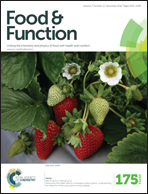Coumestrol modulates Akt and Wnt/β-catenin signaling during the attenuation of adipogenesis
Abstract
Coumestrol is a natural phytochemical present in plants such as red clover and soy, and has been reported to stimulate the estrogen receptor as a major phytoestrogen. While the molecular mechanisms responsible for the anti-adipogenic effects of phytoestrogens such as genistein and daidzein have been previously investigated, the effects of coumestrol on adipogenesis remain to be elucidated. We observed that coumestrol dose-dependently attenuates MDI (mixture of 3-isobutyl-1-methylxanthine, dexamethasone, and insulin)-induced lipid accumulation, consistent with an earlier study, while significantly inhibiting MDI-induced adipogenesis in the first 48 hours of differentiation, a critical time window for anti-adipogenic effects. Coumestrol treatment suppressed MDI-induced protein expression of PPARγ and C/EBPα in adipocytes, leading to the subsequent downregulation of FAS and aP2 expression. Akt and GSK3β were phosphorylated shortly after MDI stimulation, and these responses were inhibited by coumestrol treatment. Coumestrol also increased LRP6 protein expression, resulting in the recovery of β-catenin downregulation by MDI, while attenuating MDI-induced downregulation of Wnt10b. In addition, mRNA and protein expression of c-Myc and cyclin D1, target genes of β-catenin, were both recovered by coumestrol treatment. These results suggest that coumestrol inhibits adipocyte differentiation via regulation of Akt and Wnt/β-catenin signaling and may have potential for development as an agent to prevent adipogenesis.


 Please wait while we load your content...
Please wait while we load your content...